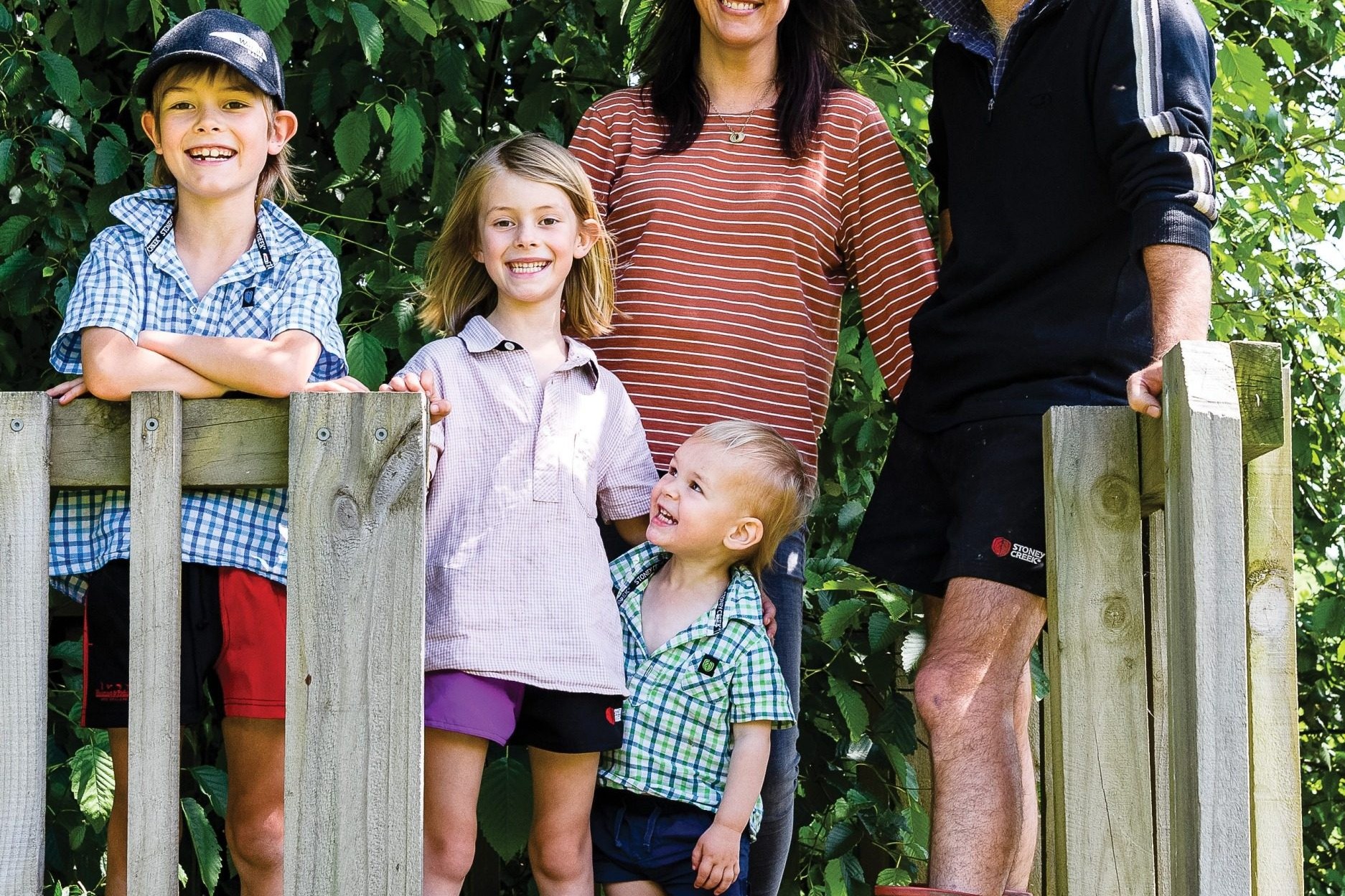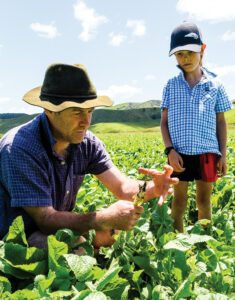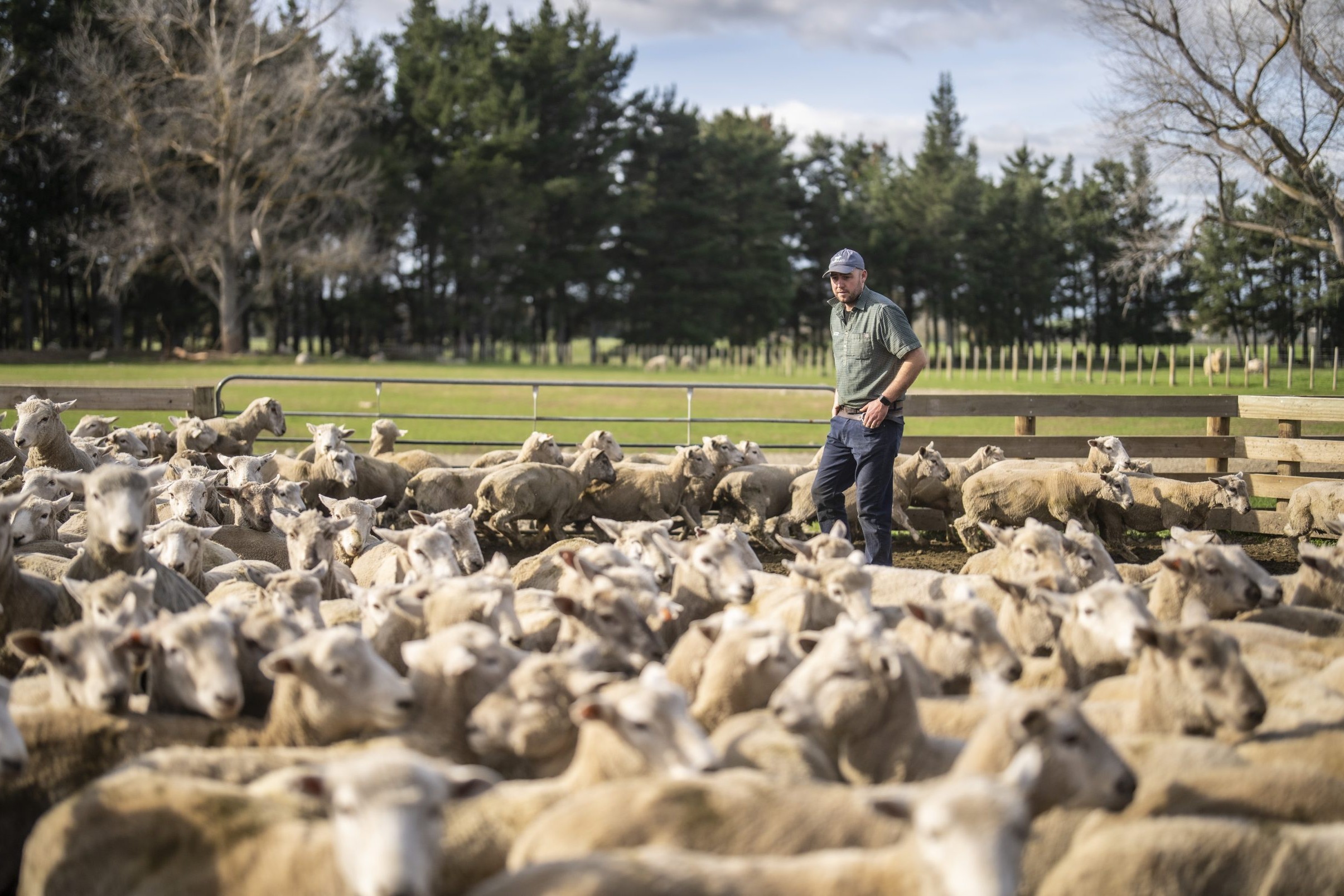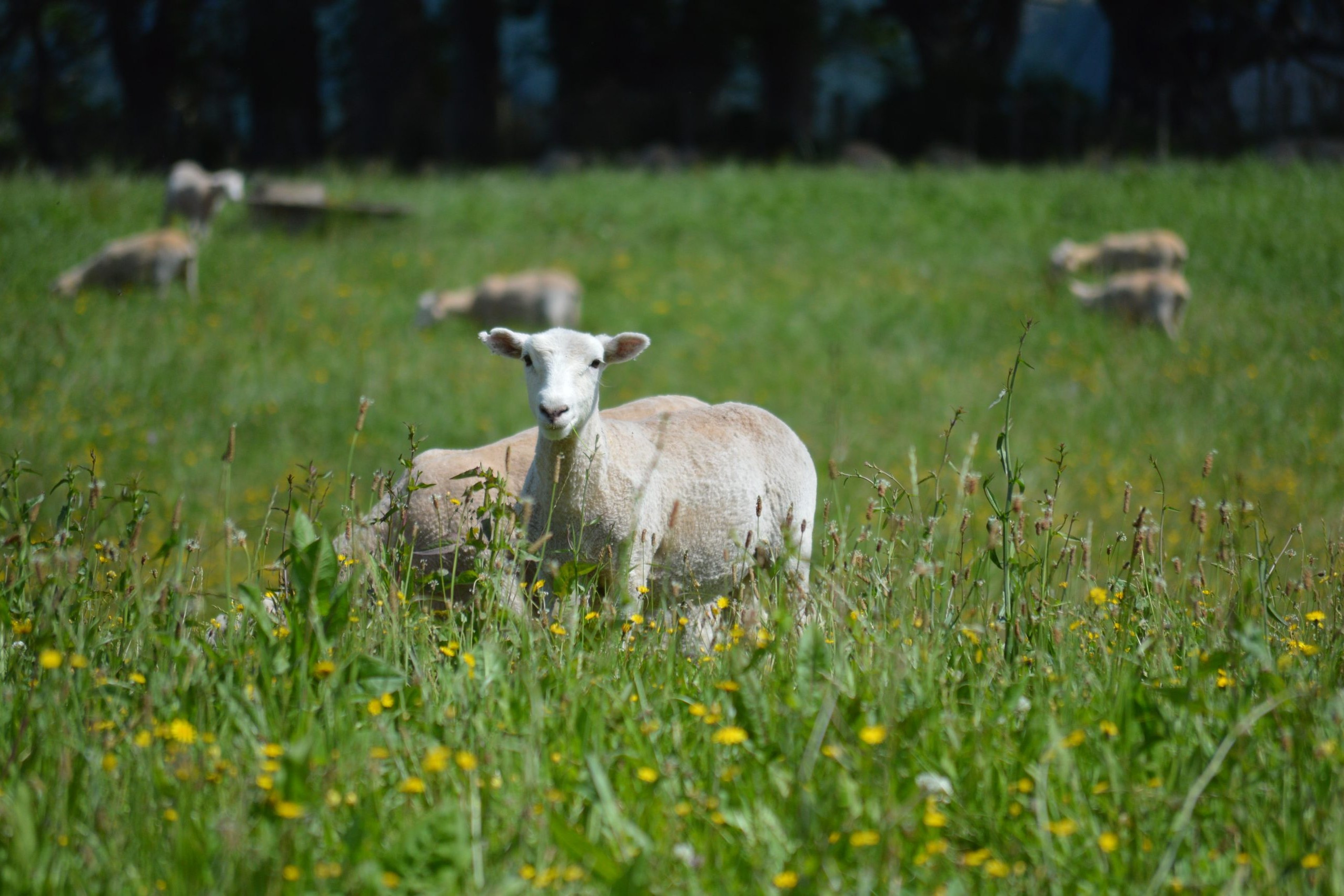Scanning cuts development time
Business planning, astute decision-making and sheer hard work have put a Wairarapa farming couple in a position to grow their business earlier than expected. Richard Gavigan reports. Photos by Mark Coote.

Business planning, astute decision-making and sheer hard work have put a Wairarapa farming couple in a position to grow their business earlier than expected. Richard Gavigan reports. Photos by Mark Coote.
Afocus on feeding, condition scoring and animal health along with the success of their livestock scanning business means James and Kate McKay can expand their sheep and beef operation 10 years ahead of schedule.
James and Kate, who have three children, farm “Te Keo” at Alfredton, 50km north-east of Masterton. They are supported by shepherd-general Ryan Cooper who has worked full-time on the farm for four years.
James and Kate bought Te Keo from James’ parents in 2015 and have been farming on their own account since then. Prior to that, James had been working on the farm while setting up his livestock scanning business.
This business, which includes calf disbudding, takes James off-farm for much of the year. While he can sometimes be home by lunchtime during the cow scanning season, ready for an afternoon on the farm, being a scanner makes for some long hard days, and Ryan and Kate are essential to the smooth operation of Te Keo in his absence.
The farm at a glance
Te Keo is 430 hectares, 380ha effective (50ha of the farm is in native bush) and a further 20ha is leased from James’ parents at Masterton. The farm is considered summer safe and has an average annual rainfall of 1200mm. It comprises 50ha of flat land, with the balance of the farm medium to steeper hill country. There are 45 hill paddocks averaging just over 7ha and 22 paddocks on the flats averaging 2ha.
Feed production on the flats includes 10ha of turnips (sown in October), 4ha of Kale (sown in October) and 36ha of plantain/white clover. All crops are direct-drilled and the plantain/white clover pastures persist for three to four years.
Te Keo winters 2050 ewes (including two-tooths), 600 ewe hoggets, 80 breeding cows, 30 carry-over dairy cows, 60 rising 2-year bulls and about 300 trade lambs. Olsen P levels range from 12-18 on the hills and are 20 or better on the flats. The McKays think that the farm’s pH (5.5–5.6) is limiting pasture production and applied 2t/ha of lime last year. Superphosphate is applied on an annual basis at a rate of 250-300kg/ha which includes a capital component of 50-100kg/ha.

Based on business planning
Physical and financial performance goals are a key component of the McKays’ business plan and a big driver of their success.
The couple began formal business planning in 2012, updating their plan annually and referring to it on a regular basis throughout the year. Goals are broken down into long-term (7–15 years), mid-term (3–7 years) and short-term (1–2 years), are clearly defined and quantified, and apply to both the farm and livestock scanning components of the business.
The McKays also use BakerAg’s annual financial analysis benchmark (FAB) to review their performance and compare it with other Wairarapa farm businesses. Submitting annual information to FAB is an important benchmarking exercise for them and the figures produced form the basis of their annual business plan and targets for the future.
Afocus on feeding, condition scoring and animal health along with the success of their livestock scanning business means James and Kate McKay can expand their sheep and beef operation 10 years ahead of schedule.
James and Kate, who have three children, farm “Te Keo” at Alfredton, 50km north-east of Masterton. They are supported by shepherd-general Ryan Cooper who has worked full-time on the farm for four years.
James and Kate bought Te Keo from James’ parents in 2015 and have been farming on their own account since then. Prior to that, James had been working on the farm while setting up his livestock scanning business.
This business, which includes calf disbudding, takes James off-farm for much of the year. While he can sometimes be home by lunchtime during the cow scanning season, ready for an afternoon on the farm, being a scanner makes for some long hard days, and Ryan and Kate are essential to the smooth operation of Te Keo in his absence.
The farm at a glance
Te Keo is 430 hectares, 380ha effective (50ha of the farm is in native bush) and a further 20ha is leased from James’ parents at Masterton. The farm is considered summer safe and has an average annual rainfall of 1200mm. It comprises 50ha of flat land, with the balance of the farm medium to steeper hill country. There are 45 hill paddocks averaging just over 7ha and 22 paddocks on the flats averaging 2ha.
Feed production on the flats includes 10ha of turnips (sown in October), 4ha of Kale (sown in October) and 36ha of plantain/white clover. All crops are direct-drilled and the plantain/white clover pastures persist for three to four years.
Te Keo winters 2050 ewes (including two-tooths), 600 ewe hoggets, 80 breeding cows, 30 carry-over dairy cows, 60 rising 2-year bulls and about 300 trade lambs. Olsen P levels range from 12-18 on the hills and are 20 or better on the flats. The McKays think that the farm’s pH (5.5–5.6) is limiting pasture production and applied 2t/ha of lime last year. Superphosphate is applied on an annual basis at a rate of 250-300kg/ha which includes a capital component of 50-100kg/ha.
Based on business planning
Physical and financial performance goals are a key component of the Mckays’ business plan and a big driver of their success.
The couple began formal business planning in 2012, updating their plan annually and referring to it on a regular basis throughout the year. Goals are broken down into long-term (7–15 years), mid-term (3–7 years) and short-term (1–2 years), are clearly defined and quantified, and apply to both the farm and livestock scanning components of the business.
The McKays also use BakerAg’s annual financial analysis benchmark (FAB) to review their performance and compare it with other Wairarapa farm businesses. Submitting annual information to FAB is an important benchmarking exercise for them and the figures produced form the basis of their annual business plan and targets for the future.
Making it happen
Sheep performance has improved significantly in recent years. While ewe scanning has always been good (about 175% not counting triplets) docking has increased from 125% to 145% in the last 10 years and average lamb weaning weights have also improved to 31kg in 2020. In 2021, 100% of Te Keo’s 600 Romney ewe hoggets were mated on April 20 at an average liveweight of 46kg and a minimum of 40kg. This age-group of sheep have scanned 130% and docked 90% (ewe hoggets put to the ram) for the last two years and have weaned lambs at 30kg average just after Christmas.
Kate credits some of this progress to getting involved in the StockCare (formally Sheep for Profit) programme in 2011. StockCare has a strong animal health focus and employs strict body condition score and liveweight monitoring protocols. Samples of Te Keo ewes are condition scored at weaning, pre-mating, mating, ram removal, scanning, set stocking and docking.
Much of the improvement in sheep performance can also be attributed to an emphasis on feeding and growing to be gained financially from bringing the early lambers down to the most productive pastures at the front of the farm than in trying to do something special with triplets.
The McKays’ biggest sheep production challenge is lamb survival, with anything from 17-24% lost between scanning and docking in any one year. A large part of Te Keo faces south and little can be done to mitigate the effects of cold southerly weather during lambing, but the McKays have a multi-faceted approach to improving weaning percentage in the future.
When selecting Romney sires, close attention is paid to index information on the number of lambs born and the number of lambs reared. At set-stocking, a minimum ewe body condition score of 3.0 and 1200kg drymatter (DM)/ha pasture cover are targeted to optimise ewe colostrum production and improve lamb survival. Also, spring nitrogen application and adjusting ewe set-stocking rates are tools that can be used to improve lactation and weaning results.
Sheep health management is an important focus, although the McKays are now looking to reduce their animal health expenditure from a high $6.76/su to $4.80/su.
At the moment, all lambs are vaccinated at docking and weaning with a five-in-one vaccine containing vitamin B12 and selenium, and are drenched pre-weaning, at weaning and every 28 days through to June. They are vaccinated for toxoplasmosis and campylobacteriosis and receive a drench capsule at pre-lamb shearing in August.
Two-tooth ewes are vaccinated for salmonellosis, are boosted for campylobacteriosis and are drenched with a triple combination anthelmintic 10 days before the rams go out. All ewes receive a mineral drench containing iodine before lambing, although this may not continue. The ewes are shorn twice a year in December after weaning, and at the end of May.
Cattle
Beef breeding cows, carry-over dairy cows and rising-two-year bulls make up the McKays’ cattle system. Eighty “as-long-as-they’re-black” breeding cows are mated to Charolais bulls on December 20 to calve on October 1. The weaner heifer calves are sold in March, and the bull calves are finished on plantain/white clover, all sold prime at 15 months in mid-January at an average carcaseweight of 270kg.
The weaners grow well on the flats, averaging 2kg LW day, but bloat can be an issue due to the high clover content. Because
of this, all weaner bulls are given a bloat capsule, but vigilance is still required. The McKays think the breeding cows are a useful pasture management tool and complement the sheep system on Te Keo. Replacements are bought as scanned-in-calf cows in April each year.
James says the carry-over dairy cows are a profitable stock class. Thirty are bought in April, put to the bull in June and sold just before calving in March as autumn-calvers. They can also be used as a pasture management tool, although not to the extent of the breeding cows due to their less-aggressive grazing habits.
Sixty rising two-year Friesian bulls are bought in late winter at 400-450kg liveweight and are typically all sold prime by the end of January at an average of 300kg CW. The bulls are rotated with hoggets with lambs at foot on the hills.
Scanning business
James McKay Sheep Scanning Services was established in 2011, with the Ultra-Scan (cow) pregnancy testing and calf disbudding franchise bought in 2016. These days, James hits the road in December and works through into April pregnancy testing dairy cows up to five days each week. He starts scanning sheep towards the end of May and works at least five days a week until the beginning of August when the calf disbudding starts.
Disbudding continues until the end of October, with November and December the only months of the year when James is not busy off-farm. In total, James handles 35,000 cows, 130,000 sheep and 12,000 calves each year, providing service to 80 farmer clients.
When he first started sheep scanning James would often scan seven days a week and up to 50 or 60 days in a row. He usually left for work before the kids woke and would often have to head out on the farm almost as soon as he got home.
Scanning in the weekends was standard practice. However, the McKays have streamlined their activities in recent years. The employment of Ryan Cooper, improvements to farm infrastructure including three sets of satellite yards, and Kate’s role in farm and scanning business administration means that James is now able to spend more time with the family and on the farm in the weekends.
While it’s hard work, the McKays’ livestock scanning and calf disbudding business has been integral to fast-tracking their farm development plan, paying off debt quickly and setting up their business growth and farm succession plans. What was originally forecast to take 15 years has been completed in five years, and they are now actively seeking opportunities to expand their farming business.
PHYSICAL PERFORMANCE TARGETS:
Long-term goals (7 – 15 years)
- Produce high quality meat and wool.
Mid-term goals (by 2024 – 2028)
- 150% lambing in ewes
- 100% lambing in hoggets
- 32kg average lamb weaning weight
- 40% of sale lambs sold prime at December weaning at 17kg CW average
- 90% calving.
Short-term goals (by 2022 – 2023)
- 145% lambing in ewes
- 90% lambing in hoggets
- 32kg average lamb weaning weight
- 90% calving
- 260kg average bull CW
- 240kg average calf weaning weight.
FINANCIAL PERFORMANCE TARGETS:
Long-term goals (7 – 15 years)
- Run a financially stable business with increasing profitability.
Mid-term goals (by 2024 – 2028)
- $1500/ha gross farm revenue
- $700/ha economic farm surplus
- Invest 10% of equity off-farm.
Short-term goals (by 2022 – 2023)
- Maintain regular contact with the accountant and bank manager
- Monitor and manage personal drawings
- Continue to pay off debt
- Monitor livestock scanning business costs and adjust where necessary
- Reduce animal health expenditure to $4.80/su (now $6.76/su).




